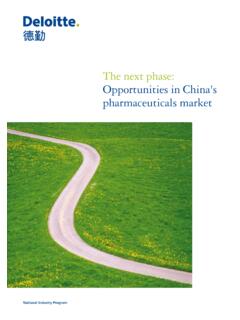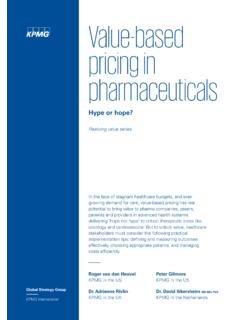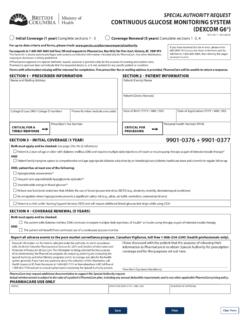Transcription of 7 Market Access Trends for 2027 - IQVIA
1 7 market access trends for 2027 Political, regulatory, and economic issues are transforming Market Access for the life sciences industry, increasing payer price sensitivity and challenging willingness to pay. IQVIA examines how current Trends and less predictable game changing forces will shape the landscape in 2027 to help you navigate Market AccessFor the best experience, we recommend downloading this interactive PDF and viewing with the latest version of Adobe Reader, a free program available at healthcare Market is in a state of continuous flux and uncertainty. Drug costs have generally grown at a slower rate than overall healthcare costs; however, as payers continue to look for ways to manage their overall spend, pharmaceuticals are a clear target.
2 While scientific innovations are revolutionizing the treatment of multiple diseases in ways never before possible, the life sciences industry faces increasing Market Access pressure. What will the 2027 Market look like? Here s a snapshot: Overall spending on medicines in the (Wholesale Acquisition Cost) is expected to double from 2015 to 2027 ( CAGR) Approximately 20% of the population will be over the age of 65 (compared to 15% today) Medicare spending as a percentage of federal budget will increase from 15% to over 18% Specialty medicines will exceed 50% of pharmaceutical spendingThere are things we cannot predict.
3 The Affordable Care Act currently remains a core part of the framework for healthcare. Will it eventually be replaced in whole or part by something else? Will the reimbursement and coverage approach for Medicare Part D and Part B change in 10 years? Likely but crystal balling these changes will only get us so far. In the interim, there are core Trends that will define how to engage in today and tomorrow s healthcare Market . Industry leaders need to understand the long-term implications of the evolving landscape and take proactive steps to secure their companies future. This means looking beyond the immediate landscape, and adapting to change in the years to more things change, the more they stay the same - some Trends are merely incrementalism more of the same pressures we have seen over the last 10 years.
4 The old tactics we use today will have to be continually honed and refined. Others will more dramatically shift Market engagement. New strategies and new approaches will be required to succeed. In our 7 market access trends for 2027 , we combine internal expertise and IQVIA analytics with insights from industry thought leaders to shift the focus a decade OF THE SAMEGAME CHANGERSIDENTIFIED Trends FELL INTO TWO CATEGORIESTO VIEW A TREND CLICK ON THE NUMBERED of the SameGame ChangersHOMECONTENTSBACKIMPLICATIONSNEXT TRENDSTIGHTER, MORE FRAGMENTED PAYER MANAGEMENTP harma will continue to feel the payer grip tighten as management across all brands increases.
5 However, Access position will be more mixed than Care Organizations (MCOs) and Pharmacy Benefit Managers (PBMs) are increasingly utilizing strict management approaches such as NDC blocks, closed formularies, and formulary exclusion policies to manage drugs, including innovative and specialty medicines. Formulary exclusions are among the most striking of these actions, and 2017 saw this tactic becoming more common. PBMs and health plans were excluding certain prostate cancer drugs from commercial formularies due to contracting and perceived clinical equivalence. Meanwhile, certain branded Chronic Myeloid Leukaemia agents were excluded from select commercial formularies due to the launch of a generic version of Gleevec (imatinib).
6 While payers will continue to be opportunistic across all therapeutic areas, the old rules will still apply - state mandates that support broader Access for oncology and protections for ongoing patients will hold, but the pressures will be higher. We have already seen specialty products become less special when it comes to Access , and it is likely that protected classes will be less protected. Over the coming decade this trend will result in a greater fragmentation of coverage across states and payer groups, as well as slower uptake of new products (See Figure). In order to minimize impact, industry will need to invest more in expert teams who engage earlier; negotiate directly with providers for Access ; and provide robust evidence of the clinical and cost-effectiveness of PATIENT OUT OF POCKET PAYMENTSS olutions are needed as financial pressures on patients mount.
7 Today, payers are transferring a higher percentage of costs to patients through increased premium, deductibles, and out-of-pocket (OOP) payments. By 2027 the percentage of covered workers enrolled in an HDHP/HRA or HSA-Qualified HDHP could rise to 56% vs. 28% in 20161 (See Figure 1). Since 2014, co-pays have risen by more than 14% (See Figure 2) and are likely to continue to rise. Today, the average family has a coverage premium of approximately $18,000, a figure that is expected to rise to approximately $25,000 by 2027 (See Figure 3). Patients fear financial toxicity a term that has become part of the political dialogue and speaks to the distress patients experience as healthcare costs and OOPs soar.
8 Under the Affordable Care Act (ACA), expanded eligibility for Medicaid, and certain insurance plans, some patients have enjoyed free prescription benefits. However, if the ACA is repealed or replaced with a more fiscally conservative plan, OOP cost growth for patients will be have been working actively to address this issue through co-pay card programs and foundation support - with co-pay card penetration across oral oncology drugs increasing from in 2010 to in 2016. Between 2014 and 2016, manufacturer co-pay offset across retail brands increased by 32%. But is this sustainable? Industry will not be able to unilaterally fix these system-wide problems or force politicians to legislate.
9 As more co-pay card programs face increasing scrutiny, new approaches will need to be considered. Companies can take a stand on protecting patients by forging new multi-lateral agreements with payers to establish limits to OOP costs for patients, and working directly with patients to disrupt a flawed Family Foundation and IQVIA analysisHOMECONTENTSBACKIMPLICATIONSNEXT TRENDSINCREASE IN VALUE-BASED MODELSV alue moves from buzzword to business expect a continued increase in value-based payment models and innovative agreements as organizations work to remove regulatory hurdles and companies invest in lowering data and administrative barriers.
10 At the same time, the concept of structured value frameworks that lay out rubrics to assess value will also proliferate, but it is unlikely that one model or framework will be preferred and dominate the pricing the most notable value frameworks currently in use in the are the Institute for Clinical and Economic Review (ICER) value framework, American Society of Clinical Oncology (ASCO), and National Comprehensive Cancer Network (NCCN). Each of these frameworks has different approaches, criteria, outputs, and target therapeutic areas. Academic, policy group, and patient group value framework approaches have also entered the Market .









